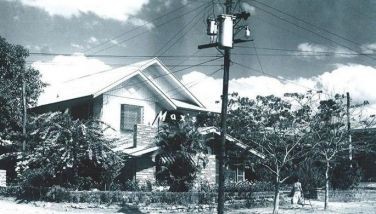A ‘perfect storm’ in Mindanao

On the surface it seems that the furor over acute power supply shortage has quieted down in Mindanao as politicians and voters focus on the election campaign for the national and local elections this coming May 13. But such calm could be foreboding, especially when a brewing confluence of major socio-political and security problems – that were being swept under the rug – might get out of control.
Although summer is upon us, such a scenario could trigger what could be likened to a “perfect storm†in Mindanao. Worse, it might break out come election day when we again use automated voting machines that run on electricity. The acute power supply situation in Mindanao could fan further tension in this part of the country where there are very serious peace and development issues.
At one hand, there is still the unresolved problem of the Sultan of Sulu’s proprietary claims on Sabah. The administration of President Benigno “Noy†Aquino III earlier blamed a bureaucratic mess-up for the government’s failure to listen to the appeal of Sultan Jamalul Kiram for Philippine action to assert the proprietary claims of the Sultanate of Sulu over Sabah. Malaysian police operations to drive away the Kirams and their followers in Lahad Datu back to Sulu have already caught international attention to the Philippine government’s tenuous hold on the security situation in Mindanao.
This tragicomedy of the country’s territorial claim on Sabah tarred a positive image carefully laid out by the Aquino administration to drum international support for Mindanao’s development. These things were being prepared as the Philippine government nears the conclusion of a final peace agreement with the secessionist Moro Islamic Liberation Front (MILF).
We can add this serious concern on security matters to the inability of Mindanao’s economy to move forward despite abundance of indigenous natural resources. There is no lacking in imagination and perseverance among Mindanaoans and, perhaps, even by the national government itself to tap this natural wealth to the hilt.
Sadly though, Mindanao never was able to move beyond being a retrogressive southern backdoor of a backsliding prospective Asian tiger economy. Not only because of the serious lack of modern infrastructure such as ports, roads, bridges, reliable communication facilities, but most important of all, Mindanao badly needs a reliable supply of electricity to crank into action these economic activities.
Since the Republic’s inception in the 1930s, Mindanao has been popularly called the “land of promise.†Now, it is more known as the “land of darkness†because of these rotating blackouts and daily power outages that have been hobbling Mindanao folks.
Except for Davao City and Cagayan de Oro, daily blackouts average six to eight hours at the onset of summer in the region. The power supply shortage has already caused significant reduction in the productivity of industries and businesses in Mindanao, particularly in major urban centers like Iligan, Butuan, General Santos, and Zamboanga cities. In the Socksargen region in Southern Mindanao alone, the local chamber of commerce has estimated business losses arising from higher operating costs to reach as much as P100 million a month this summer.
It’s a welcome relief that the private sector took the initiative given the government’s failure to act with dispatch. For instance, Mapalad Power Corporation owned by the Alcantara Group switched on portions of the 98-megawatt Iligan Diesel Power Plant last April 19, the first real contribution to easing the four to eight-hour daily brownouts throughout Mindanao.
It had been a year already since President Aquino himself declared during a hastily called Mindanao Power Summit in April last year that the Iligan power facility is a “vital immediate solution†to the Mindanao power supply crisis. But it took that long to complete a diligent review by the Commission on Audit of the power plant’s auction by the Iligan city government won by Mindanao-focused Alcantara Group, one of the independent power producers rushing baseline projects such as the 105-megawatt coal-fired power plant in Maasim, Sarangani province and another 105-megawatt power plant in San Ramon, Zamboanga City.
However, Mindanao would have to live with and cope with the blackouts for the next two years at least. These new power plants, along with those of the Aboitiz Group and STEAG of Germany, are expected to end the Mindanao power crisis only by 2015, as President Aquino himself announced last week.
With the country now rated investment grade by Fitch Ratings, it should be easier for the government to lure more job-generating foreign direct investments. Mindanao in particular can use more investments both foreign and local. But investors will obviously have to wait and see until 2015 if indeed the power supply situation in Mindanao improves.
In addition to the power supply crisis, we can add the specter of climate change as one of the new miseries facing Mindanaoans. The areas of southern Philippines that have never had typhoons and tropical storms for centuries have now become disaster zones. Billions of pesos worth of agricultural crops, private property and businesses, not to mention lives lost because of these nature-induced disasters.
A worst-case scenario bedeviling many in Mindanao is the prospect of power outages in most parts of Mindanao on May 13 that could put to question the voting process and the transmission of the results when voting precincts close. The Comelec has promised to deliver generator sets as backup source of power.
Despite these Comelec assurances, many still worry this is a very serious situation that could exacerbate an already volatile political and security situation and allow troublemakers to push their agenda.
P-Noy himself was not spared by the blackouts during his campaign sorties in Mindanao to help pitch for his administration-backed candidates. With two-digit popularity rating and being picked by Time Magazine as among the most influential leaders, P-Noy would just wait it out until 2015 for the power supply problem in Mindanao to solve itself.
With the midterm national and local elections just around the corner, Mindanao really seems to be heading for a “perfect storm†that could wreak havoc all the way to Malacañang. But who cares?
- Latest
- Trending























